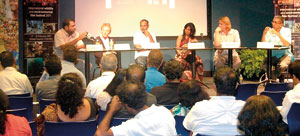I still remember my first experience of Knuckles in the early’80s where I enjoyed the endemic Horned Lizards and unique Knuckles landscapes. However I was not physically in Knuckles, but was watching a documentary. The fact that I still remember this documentary after almost three decades highlights the power of a good wildlife film.
We now have the luxury of seeing the wilder side of nature through Discovery Channel, National Geographic or Animal Planet through cable TV, but shouldn’t we have more and more local wildlife films?
To encourage local environmental film makers to make more such documentaries was a main aim of the Wildscreen Festival 2011 held at British Council from February 17 to 19. The Wildscreen Festival is internationally acknowledged as the most influential and prestigious event of its kind held in the UK once in two years. To popularize environmental films, the Wildscreen Festival also makes a global round. This was Wildscreen’s second appearance in Sri Lanka.
 |
The panelists (L to R): Taya Diaz, Amanda Theunissen, Delon Weerasinghe, Anoma Rajakaruna, Dominic Weston
and Nalaka Gunawardene |
The Film Festival not only screens a few films, but also aims at grooming budding film makers, on the environment. With this aim, a session of sharing knowledge with experienced Wildlife documentary makers both local and from the UK was organized. Amanda Theunissen and Dominic Weston from the UK and Delon Weerasinghe, Anoma Rajakaruna and Taya Diaz from Sri Lanka addressed the common challenges faced by wildlife and natural history film makers such as the art of effective story telling, fund raising and ensuring wide distribution for films made.
Director of TVE Asia Pacific, Nalaka Gunawadene opened the session recalling the opening sentence of Our Common Future, the 1987 Report by the World Commission on Environment and Development. “The Earth is one but the world is not”.
“A similar disparity exists in wildlife and natural history film making. We are all concerned about and covering the same planet Earth in all its diversity. But on this planet there are many different worlds of film making,” Nalaka said. The panelists recognized that wildlife and natural history making traditions in South Asia are different from those in Europe and North America where TV stations invest funds upfront in films under production, in return for exclusive rights.
“Most TV broadcasters in our part of the world have no tradition of commissioning factual films or documentaries. Government funding schemes are rare and difficult to access. To make issue-based films, we have to find individual donors, corporate sponsors or foreign sources of funding,” said Anoma Rajakaruna, who has been in the business for over two decades.
Taya Diaz, a film director who was involved in the famous BBC wildlife documentaries like the Temple Troop that showcased the monkeys in Polonnaruwa, said, local film makers should create more content aimed specifically at their own local audiences. He urged Sri Lankan naturalists, wildlife experts and environmentalists to collaborate more closely with film makers and broadcasters to make more local films aimed at local audiences.
Amanda Theunissen who who has worked with the BBC Natural History Unit and National Geographic Television, stressed that coming up with the right idea was no longer sufficient: film makers also need to master the art of writing proposals, making ‘pitches’ to attract the attention of broadcasters and/or funders, networking with film distributors and other skills needed for raising funds from public, private or philanthropic sources.
The Davids do their bit around the world
A Canadian based twosome calling themselves Davidwithout Borders who do short documentaries on success stories of biodiversity conservation and publish them on their website was also in Sri Lanka. A TV crew for environmental documentary may remind you of a group of people carrying lots of high tech equipments, but these Davids travel around the world on their own using the minimum equipment.
“Our expedition David without Borders travels in 12 countries across the world to showcase emblematic projects of hope for biodiversity protection, shared benefits and sustainable use,” said David Aime. His partner David Fabrega is the cameraman capturing these stories.
All their documentaries including those done in Sri Lanka are distributed continuously as a Web series on www.davidwithoutborders.com. “We are two Davids who do this together and we wanted to make a unique name for the series” they explained.
They landed in Sri Lanka in December last year and “It took us only a few hours to be delighted by the warmth and the cultural beauty of Sri Lankan people. Our intention is to bring out the best initiative from the country we visit but when you are emotionally attached so quickly you try even harder,” David Aime said. But it was not so easy as they had selected a project initiated by Prof. Sarath Kotagama in Jaffna.
Getting permission to go to Jaffna was complicated, but the Davids ran between ministries to UN offices and the authorities and getting permission at the 11th hour, boarded a bus to Jaffna, and hurried to Prof. Kotagama, who had already started his workshop.
Visit www.davidwithoutborders.com to view these mentaries.
|


